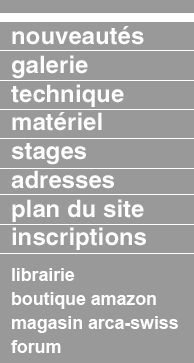

[abonnement gratuit]
l'auteur
|
Todd Stewart

Todd Stewart began his career as photographer working for advertising
and design clients in Columbus, Ohio and Atlanta, Georgia. In 2004, he
received a Master of Fine Arts degree from Indiana University. Since
that time, he has been an Assistant Professor of Photography and Digital
Imaging at the University of Oklahoma.
For many years Stewart’s concerns as an
artist have centered on the relationships between history, myth, and
culture. This work has included a growing exploration of the American
Landscape and a continued examination of the question: does place hold
memory?
Stewart is the author of two books
 
Placing Memory: A Photographic Exploration of Japanese American Internment
and the forthcoming, Picher, Oklahoma: Catastrophe, Memory,
Trauma
Stewart’s photographs have been exhibited
widely throughout the United States, recognized by museum curators at
the The Whitney Museum of American Art, The Museum of Photographic
Arts, Santa Diego; and publication editors including those from
Aperture and the New York Times Magazine.
http://toddstewartphotography.net
|
interview
En
français |
|
An interview of Todd Stewart
about
Twentysix Gasoline Stations
d'Edward Ruscha
How can you present
the book Twentysix Gasoline Stations, from Edward Ruscha,
published in 1963, to a young photographer today who might overlook
its significance?
The photograph lives in a completely
different visual culture then it did just fifty years ago. We are
inundated with images everyday, all fighting for our attention, all
digested too quickly to leave any room for subtlety or complexity.
To understand the significance of Ruscha’s Twentysix Gasoline
Stations it is important to understand the context in which it was
first published and how radically different it was from all that had
come before.
I first became aware of the book in
the late 1980’s. I had just discovered the images of Robert Adams
and Lewis Baltz and was looking for a way to understand why their
work was so compelling. I was a young photographer at the time, and
for me their photographs were nothing like the images of landscapes
I had seen or appreciated before. They were banal, deadpan views of
subjects I had never really considered “worthy” of a photograph. Yet,
somehow these photographs seemed important.
William Jenkins in the catalog to the
1975 exhibition New Topographics, had cited Ruscha’s books as being
influential precursors to the work of Adams, Baltz, and others and
when I first saw Twentysix Gasoline Stations I understood
what he meant. What I appreciated most was how this severely simple
book could be so critically dense.
What is the point of
this book for you? Is Ruscha's approach still relevant for you?
I understand the significance of the
book to both pop art and conceptual art, but for me, as someone
obsessed with the photographic image, its importance lies elsewhere.
As I stated earlier, this work was very different than other work I
was familiar with at the time. Like many photographers of my
generation, my early career was more informed by Ansel Adams rather
than Robert Adams. This led to a belief that great work was
characterized by formal elegance and demonstrations of technical
virtuosity. Robert Adams, Baltz, and especially Ruscha changed this
for me. Through their work I understood that photographs could be
about ideas. Technical and formal considerations are important, but
they are choices to be made in service to these ideas not as ends in
themselves. Through their work I began to appreciate photographs
that revealed their meaning slowly. I began to understand how an
image radically severe in its simplicity could often communicate so
much more than a conventionally beautiful photograph.
While yes, I believe this approach is
still relevant; finding an audience in a visual culture centered on
instant gratification is problematic.
Do you think that
photography is essentially documentary?
A photograph is an extremely complex
cultural object and its great power lies within its connections to
both time and to the real - two very important signifiers of
documents. But, for me photography is a highly adaptive language and
its practice is as much literary as anything else. For these reasons
it is a highly effective means for describing, interpreting, and
understanding the world around us.
Do you think the book
is the most appropriate presentation of photography?
I believe there are many effective
ways to presents photographs, but the book is certainly one of the
best – especially for someone such as myself who sees the practice
as essentially literary.
Selecting photographs
for their banality and lack of quality: this trend issue from pop
art and resolutely anti painting largely revolutionized Art ...
which confuses today commonly artistic values and social
anti-values. Do you think a new approach, based on the density and
quality of the work itself could now take place?
If I understand your question
correctly as a matter of practice, (meaning can a new approach to
image-making informed by Ruscha, but independent of his style now
take place?) the answer is yes, absolutely. In fact, I believe some
of the best of contemporary photography does just that - embracing a
return to aesthetics while remaining firmly grounded in critical and
conceptual inquiry.
|

